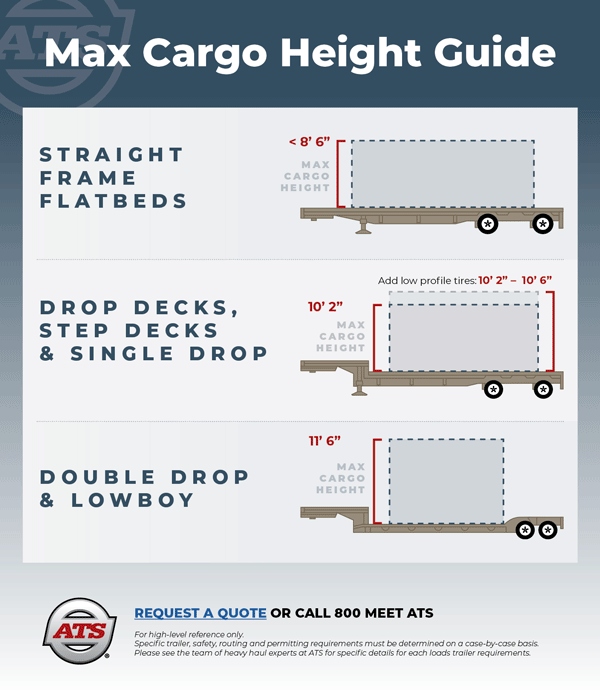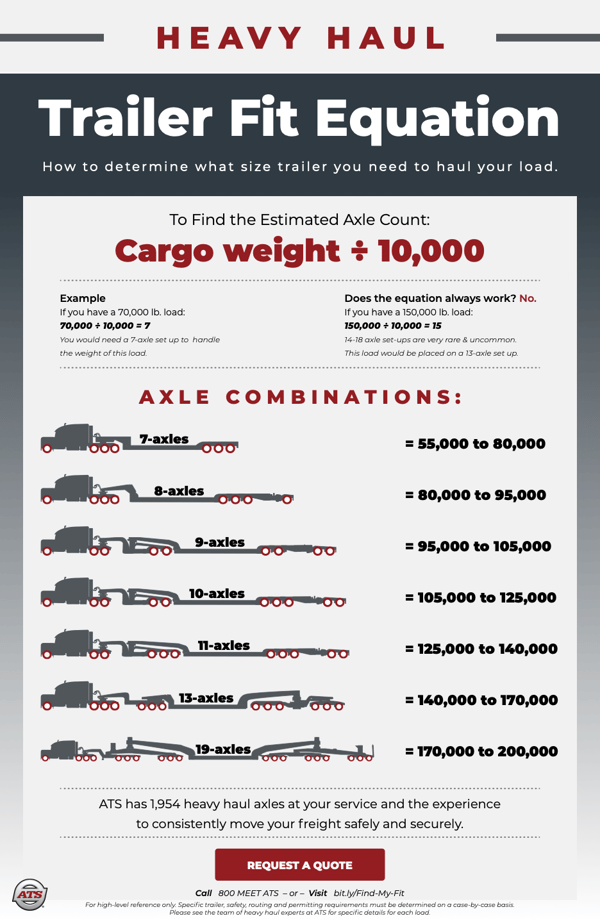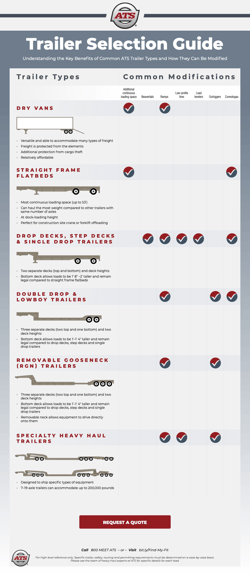 When you need to ship freight that won't fit within the enclosed dimensions of a dry van, you know you need an open deck trailer. However, you might not know there's a wide variety of open deck trailers available and your options include — but also extend well beyond — those offered by flatbed shipping.
When you need to ship freight that won't fit within the enclosed dimensions of a dry van, you know you need an open deck trailer. However, you might not know there's a wide variety of open deck trailers available and your options include — but also extend well beyond — those offered by flatbed shipping.
It's worth repeating: Not everything that's open deck is a flatbed. This is important to note because the many open deck options available range in cost and each is uniquely designed, or can be modified, to accommodate specific types of freight.
In this post we'll explain:
- The Common Types of Open Deck Trailers
- The Common Ways to Modify Open Deck Trailers
- What a Flatbed or Heavy Haul Carrier Should Do to Ensure You Have the Right Equipment
- What You Can Do to Help Specialized Flatbed and Heavy Haul Carriers Help You
- A Guide to Select the Right Trailer
The Common Types of Open Deck Trailers
It's easy to get lost in the terminology used by heavy haul carriers and flatbed freight shipping companies. You’ll often hear common, alternate descriptions that mean the same thing. And while in some cases there are only slight differences between certain types of open deck trailers, each type of trailer has its unique benefits and limitations.
Straight Frame Flatbeds
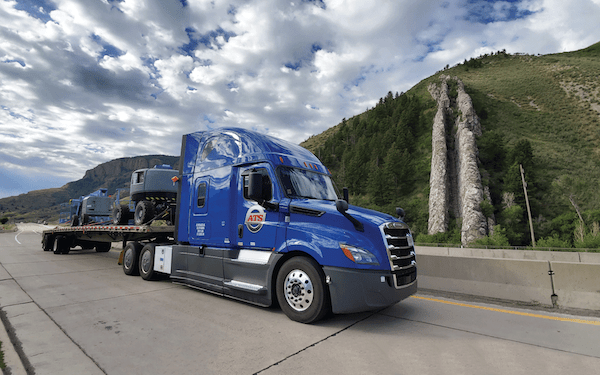
Benefits: As the most standard open deck trailer, a straight frame flatbed offers the most continuous loading space — typically up to 53 feet. And if you're picking up from or shipping to a dock, a straight frame is a great option as they're at loading dock height.
If you have a heavy load, a flatbed may be the right choice since it can haul the most weight of any trailer with the same number of axles. Additionally, if you're shipping a load that would fit onto a dry van to a construction site, you may want to choose a straight frame flatbed due to the offloading limitations of dry vans. Loads can easily be offloaded from straight frame flatbeds using a forklift or a crane.
Limitations: The height of a straight frame flatbed can impose a number of limitations. You can't drive equipment onto a standard straight frame, and you won't be able to ship high-profile freight without securing an oversized load permit (east of the Mississippi, 8 feet 6 inches is the tallest piece you can ship on a flatbed before it's considered oversized; in the westernmost 13 states, you're able to ship up to 9-foot pieces in some locations).
Drop Deck, Step Deck and Single Drop Trailers
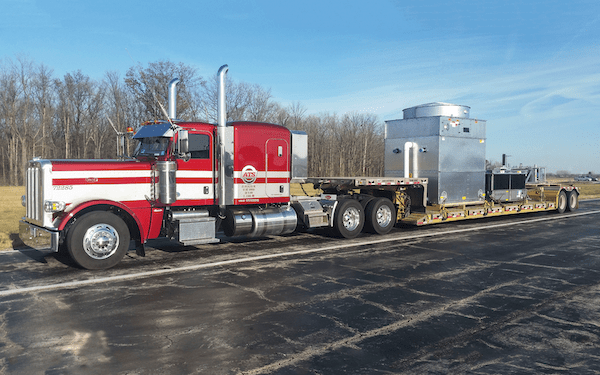
Benefits: These common descriptors all mean the same thing: This trailer type is tiered and has a top deck as well as a bottom deck that's lower than that of a traditional straight frame flatbed. This benefits you because it allows you to ship taller cargo legally on the bottom deck. In fact, if your specialized flatbed carrier uses low profile tires, you can add up to 2 feet onto the height of your cargo compared to a straight frame flatbed. Without low profile tires, your piece height can still be upwards of 10 feet 2 inches, compared to 8 feet 6 inches on a straight frame flatbed.
Limitations: Because these trailers are tiered, they have less continuous loading space compared to a straight frame flatbed. On a traditional 53-foot step deck trailer, 10 feet of loading space is on the top deck and 43 feet of loading space is on the bottom deck.
Double Drop, Lowboy and RGN Trailers
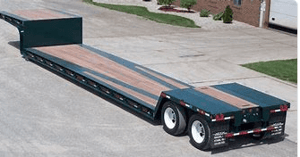 Benefits: These trailers all further increase the height of cargo you can legally ship. They all have a lower bottom deck between two top decks that allows cargo as tall as 11 feet 6 inches to ship legally. "Double drop trailers" and "lowboys" are synonymous terms, but removable gooseneck trailers (RGNs) are essentially the same trailer with one important benefit: They come with a removable neck that allows equipment to drive directly onto them.
Benefits: These trailers all further increase the height of cargo you can legally ship. They all have a lower bottom deck between two top decks that allows cargo as tall as 11 feet 6 inches to ship legally. "Double drop trailers" and "lowboys" are synonymous terms, but removable gooseneck trailers (RGNs) are essentially the same trailer with one important benefit: They come with a removable neck that allows equipment to drive directly onto them.
Limitations: Because there are two top decks and one lower bottom deck, you have less continuous load space on these trailers. They're also heavier than other trailer types, which may cause routing complications in some heavy haul shipping applications.
Comparing Maximum Commodity Heights by Open Deck Trailer Type
Below are the maximum heights of commodities that can be legally accommodated by each common open deck trailer type. Anything taller would be considered an oversized load on each respective trailer type and require a permit.
The Common Ways to Modify Open Deck Trailers
Regardless of open deck trailer type, when it comes to open deck shipping, many major trailer modifications are made based on weight and height.
If a load is particularly heavy, additional axles are added to support the weight. Sliding tandem axles can also be added to meet state-specific axle-spacing laws. If load height is the issue, different trailer types are used to help reduce the load height.
These two modifications are all about minimizing overall risk, time and money. Keeping loads shorter, legal and safe minimizes the time and money associated with oversized load permits, and it also helps ensure they won't run into as many issues and height restrictions en route.
But aside from these modifications, there are other ways open deck trailers can be modified.
- Add additional length: Many straight frame flatbed trailers are 48 feet. If you need additional continuous loading space, there are also 53-foot straight frame flatbeds available. Other trailer types, like double drop trailers and RGNs, come in expandable versions that expand beyond 53 feet.
- Steel versus aluminum: Despite steel's susceptibility to corrosion and its relatively heavy weight compared to aluminum, some people like its ruggedness. Aluminum trailers are the right choice, however, if you want enduring trailer equipment that also helps you avoid overweight shipping issues.
- Beavertails: These sloped extensions can be added to the rear of some trailers and allow equipment to be loaded via the rear of a trailer.
- Ramps: Many types of trailers can come equipped with ramps for easy, roll-on, roll-off loading and unloading.
- Tires: To further maximize load height they’re able to carry within legal limits (no permitting required), some carriers include trailers with low profile tires in their fleet. Trailers equipped with low profile tires help shippers gain an additional 4 inches of load height.
- Load levelers: These are steel frames that can be added to the bottom decks of step deck, double drop and RGN trailers. They give you the ability to have the continuous loading space found on straight frame trailers. If a carrier is short on straight frame trailers, load levelers can prove to be essential, as they allow other trailer types to perform a similar function.
- Outriggers: Commonly used on RGN trailers, these are supports that extend out of the sides of trailers to accommodate extra-wide, oversized pieces. For example, they can be used to support wide tractor tires if the tires extend beyond the width of a trailer.
- Conestogas: These are common variations of step deck and drop trailers that have rolling tarp systems attached to them. The tarp systems help protect freight from the elements and/or are used for security sensitive loads for confidentiality.
When to Consider Specialty Trailers
Sometimes you can't rely on one of the common trailer types mentioned above no matter what modifications are available. That's why leading carriers also have open deck trailers that are designed to ship specific equipment.
For example, at Anderson Trucking Service (ATS), we offer extensive support for wind turbine shipping and have special trailers, like blade trailers (used specifically to haul wind turbine blades) and Schnable tower trailers (that are designed to haul turbine towers), for these projects.
To accommodate extremely large and heavy loads up to 200,000 pounds, some carriers offer 19-axle steerable trailers.
What a Flatbed or Heavy Haul Carrier Should Do to Ensure You Have the Right Equipment
Because there are so many types of open deck trailers available — and even more ways in which you can modify them to fit your exact needs — it's always essential to rely on a knowledgeable carrier to help you make the right equipment choice.
Experienced carriers with a diverse assortment of trailer options will help you stay within budget, maximize profitability, remain on schedule, minimize cargo damage and delight customers.
There are a number of specific ways a carrier should help you to ensure you're utilizing the most efficient transportation solution possible for your unique load.
Carriers Should Leverage the Relationships They Have With Manufacturers
If you're looking to transport a large piece of equipment that's never been shipped before, it's always a good idea to reach out to a specialized flatbed or heavy haul carrier in the engineering stage.
Transportation is often the last thing on the minds of engineers, but working closely with a specialized flatbed or heavy haul carrier in the planning stage could help you avoid having an extra-large and costly-to-ship superload on your hands.
The right carrier will not only help you choose the right equipment, they'll work directly with carriers to modify trailers so that your equipment ships as efficiently and cost-effectively as possible.
At ATS, we encourage any company with equipment manufactured overseas to work with a carrier during the manufacturing stage to determine:
- The best port to ship it into
- The maximum dimensions they can make each component (so it can easily and cost-effectively get to the job site or final destination)
At this stage, a specialized flatbed or heavy haul carrier should be able to make suggestions to the equipment manufacturer and also leverage the relationships they have with major trailer manufacturers to make necessary adjustments.
Carriers Should Provide Detailed, Upfront Information About Regulations, Infrastructure, Pricing and Scheduling
With this information in hand, a specialized flatbed or heavy haul carrier can tell you if a shipment's size or weight will require you to obtain a permit given the routes available. Top carriers have in-house permitting teams that do nothing but help secure and manage permits. These teams hold in-depth knowledge of nationwide regulations and infrastructure and will be able to level-set your expectations at the time of quoting — it may take weeks to secure some permits, and you should be provided with this information up front.
In order to provide you with this detailed information upfront, top carriers will ask the right questions — likely throughout multiple conversations — to determine:
- Exact shipment descriptions, including how many pieces each shipment contains
- Precise dimensions, so they can ensure each load's center of gravity will work on each trailer type and understand wheelbase and well space requirements if necessary
During early planning, some flatbed and heavy haul carriers will even go through the effort of overlaying Google Maps with CAD files to determine how much space they have to work with at the loading site and final destination — this is especially true with larger loads being hauled on RGNs.
The more information carriers have up front, the more accurate your estimate will be overall, from a permitting, scheduling and cost perspective. This information will also allow a heavy haul carrier to strategically plan, as many trailer types can be modified to accommodate the same load. Sometimes it comes down to working with the assets on hand.
When it comes to pricing, leading carriers will put you in control by providing exact pricing up front that doesn't fluctuate. Because some carriers only supply estimated pricing, it's important to ask questions and understand what an estimate includes and whether it's final.
Many carriers will provide estimated pricing and then come back with a higher, final price after they hauled the load. Other carriers will come back with additional charges for items like fuel that weren't included on the bid.
Carriers Should Always Offer the Best Drivers and Well-Maintained Trailers
Whether legal or oversized, all shipping can be complicated, which means trustworthy companies should offer extensive training programs for Drivers. Carriers should start each Driver shipping legal-sized loads and only gradually approve them to ship increasingly heavy and oversized loads after they achieve key milestones. For this reason, most ATS Heavy Haul Drivers have decades of experience under their belts prior to hauling the extremely large 19-axle loads.
Rigorous maintenance schedules are just as important as extensive Driver training programs.
Top heavy haul carriers should always have large, diverse trailer pools that allow these rigorous maintenance schedules to occur. This ensures there's always availability and never any hasty repairs.
As a shipper, you should always ask prospective carriers what their maintenance schedules look like. It may seem like a given, but many carriers don't service their trailers on a regular basis.
What You Can Do to Help Specialized Flatbed and Heavy Haul Carriers Help You
While top carriers will do their best to find the right open deck trailer for your needs, sometimes, as the saying goes, a picture (or a drawing) is worth 1,000 words.
A drawing or picture of your shipment will allow carriers to determine exactly what trailer type is needed and the load's securement points.
Sometimes dimensions aren't enough, and here's one example where that's the case:
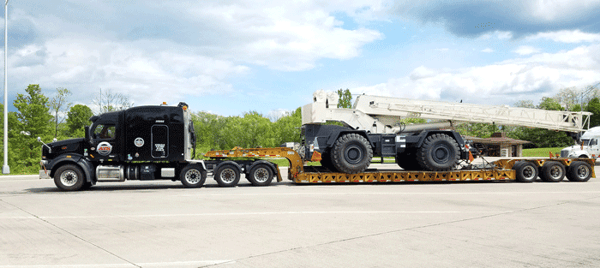
In this example, if a customer were to only share the dimensions of the rough terrain crane (12 feet tall and 40 feet long), a carrier would've thought that a much longer trailer or inserts were needed. But by looking at a photo of the equipment, a carrier could see that 20 feet of the load is a boom that can span over the deck of the trailer and doesn't require well space. So instead of requiring 40 feet of continuous well space, the shipment only requires half of that, which completely changes the trailer configuration needed and reduces the cost and timing of the shipment.
There's a lot that goes into choosing the right open deck trailer for a shipment. There are usually many ways to approach each scenario, as there are many different trailer types and multiple ways to modify each.
Your carrier should help you make the best final decisions, but in the meantime, here’s an at-a-glance reference that will guide you in choosing the best trailer equipment for your shipments. If you have any questions about ATS' specialized flatbed or heavy haul shipping solutions, reach out today.
